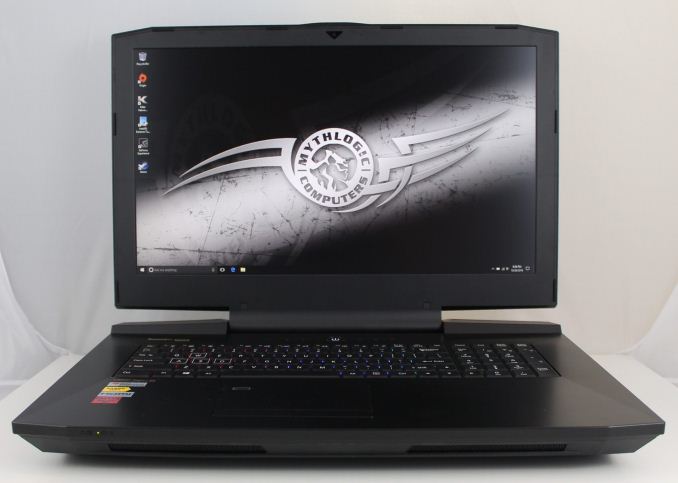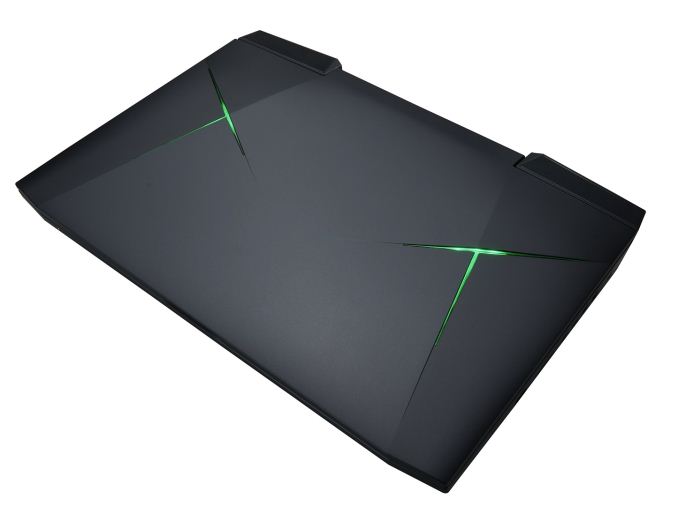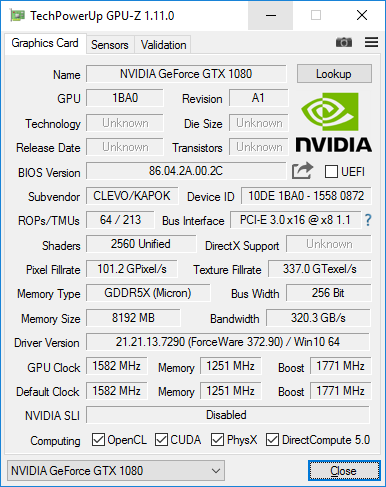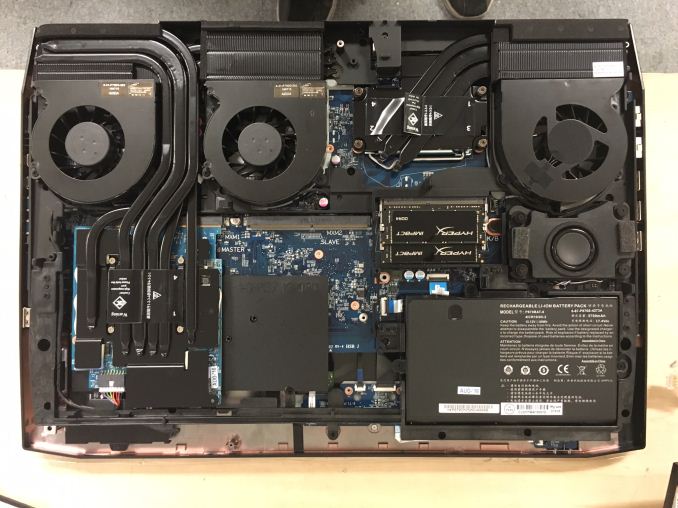The Clevo P870DM2 / Mythlogic Phobos 8716 Laptop Review: DTR With GTX 1080
by Brett Howse on October 27, 2016 2:00 PM EST
Sometimes there is no substitute for performance. Most of the laptop market is focusing on thin and light designs, with companies attempting to outdo each other by shaving a millimeter or two off of their laptop z-height compared to the competition. But in the Desktop Replacement (DTR) category, there are no such concessions. Clevo is one of the few laptop makers that is in the DTR market, and thanks to the assistance of Mythlogic, we have the Mythlogic Phobos 8716 DTR for review today. As a Clevo, the model would be P870DM2.
Let’s cut right to the chase. The Mythlogic Phobos 8716 is a beast of a laptop, and really should rarely be used in your lap. It is designed for someone who needs the ultimate performance, but still needs something more portable than a full desktop. This is a 17.3-inch display packed into a chassis that is 47.2 mm thick (1.86”) and weighs in at 5.5 kg (12.13 lbs) with a single GPU. And yes, you can opt for two GPUs, which ups the weight and moves you into the land of ridiculous.
Mythlogic offers a couple of choices of CPU and GPU, but all the CPUs are desktop parts, from the Intel Core i5-6400 65-Watt processor up to the Intel Core i7-6700K 91-Watt processor (as we have in the review unit). This is the same unlocked quad-core as you would find in any high performance desktop. On the GPU side, the base model is a mere GTX 1070, or step up to the GTX 1080, or either card in SLI. If you get dual GTX 1080 GPUs, be prepared to have two AC outlets handy for the dual 330-Watt AC Adapters. Mythlogic also supports overclocking on all of the components. There are four SODIMM slots for up to 64 GB of DDR4 memory as well. This is well and truly a desktop class computer packed into a (somewhat) portable chassis.
The display options also need mentioning too. The standard panel is a 1920x1080 IPS display with a 120 Hz refresh rate. That should be a very significant upgrade for almost anyone, up from the ubiquitous 60 Hz laptop displays. They are also offering a 2560x1440 AHVA 120 Hz panel with G-SYNC option, and a 3840x2160 60 Hz AVHA panel which also includes G-SYNC.
| Mythlogic Phobos 8716 / Clevo P870DM2 | |
| As Tested: 6700K, 16GB (2x8) 2400 DDR4, 1x1080, 256GB Samsung 950 Pro m.2, 120Hz FHD, $2980 USD |
|
| CPU | Intel Core i5-6400, 4C/4T, 2.7-3.3 GHz, 6MB Cache, 65W TDP |
| Intel Core i5-6500, 4C/4T, 3.2-3.6 GHz, 6MB Cache, 65W TDP | |
| Intel Core i5-6600, 4C/4T, 3.3-3.9 GHz, 6MB Cache, 65W TDP | |
| Intel Core i5-6600K, 4C/4T, 3.5-3.9 GHz, 6MB Cache, 91W TDP | |
| Intel Core i7-6700, 4C/8T, 3.4-4.0 GHz, 8MB Cache, 65W TDP | |
| Intel Core i7-6700k, 4C/8T, 4.0-4.2 GHz, 8MB Cache, 91W TDP | |
| GPU | NVIDIA GTX 1070 8GB, 2048 CUDA Cores , 1442 - 1645 (Boost) MHz Also available as 2 x SLI |
| NVIDIA GTX 1080 8GB, 2560 CUDA Cores, 1556 - 1733 (Boost) MHz Also available as 2 x SLI |
|
| Memory | 4 SODIMM Slots, 64 GB Max, up to 3000 MHz |
| Display | 17.3" 1920x1080 IPS 120Hz Optional 2560x1440 AHVA 120 Hz w/G-SYNC Optional 3840x2160 AHVA 100% Adobe RGB w/G-SYNC |
| Storage | 2 x 9.5mm 2.5” SATA 2 x m.2 Slot (SATA or 4xPCIE) |
| I/O | 5 x USB 3.0 Ports (1 x powered USB port, AC/DC) 2 x USB 3.1 / Thunderbolt 3 Port (Type-C) 1 x HDMI 2.0 output Port (with HDCP) 2 x DisplayPort 1.3 output Ports SD Card Slot 1 x Headphone Jack 1 x Microphone Jack 1 x Line-in Jack 1 x S/PDIF (digital) (Shared with headphone jack) 2 x Killer E2400 RJ-45 LAN (10/100/1000Mbps) |
| Dimensions | 428 x 308 x 47.2 mm 16.85 x 12.12 x 1.86 inches |
| Weight | 5.5 kg / 12.13 lbs (single GPU) |
| Battery | 82 Wh, 330W / 230W W AC Adapter |
| Wireless | Intel Dual Band Wireless-AC8260 2x2:2 with Bluetooth 4.1 Killer Wireless-AC 1535 2x2:2 with Bluetooth 4.1 |
| Price | $2255 - $5000+ |
There is no shortage of ports, with five USB 3.0 ports, two USB 3.1 Type-C ports with Thunderbolt 3, HDMI 2.0, two DisplayPort 1.3, and separate audio jacks for the headphone, microphone, and line-in. It also features a Killer E2400 Ethernet adapter, and that wired connection can be paired with either the Killer 1535-AC wireless to support Killer’s DoubleShot Pro, or Intel’s Dual Band Wireless-AC 8260 card if you prefer their solution.
With a starting price of $2255, the Mythlogic Phobos could never be considered inexpensive, but on the performance per dollar metric, there are few laptops that offer this kind of performance period, let alone for the price.













61 Comments
View All Comments
BrokenCrayons - Thursday, October 27, 2016 - link
Minor details...the MYTH Control Center shows an image of a different laptop. It struck me right away because of the pre-Pentium MMX Compaq Presario-esque style hinge design.As for Pascal, the performance is nice, but I continue to be disappointed by the cooling and power requirements. The number of heat pipes affixed to the GPU, the fact that it's still reaching thermal limits with such cooling, and the absurd PSU requirements for SLI make it pretty obvious the whole desktop-class GPU in a laptop isn't a consumer-friendly move on NV's part. Sure it cuts back on engineering, manufacturing, and part inventory costs and results in a leaner organization, but it's hardly nice to people who want a little more than iGPU performance, but aren't interested in running up to the other extreme end of the spectrum. It's interesting to see NV approach the cost-cutting measure of eliminating mobile GPU variants and turning it into a selling point. Kudos to them for keeping the wool up on that aspect at least.
The Killer NIC is something I think is a poor decision. An Intel adapter would probably have been a better choice for the end user since the benefits of having one have yet to be proven AND the downsides of poor software support and no driver flexibility outweigh the dubious claims from Killer's manufacturer.
ImSpartacus - Thursday, October 27, 2016 - link
Nvidia just named their mobile GPUs differently.Fundamentally, very little has changed.
A couple generations ago, we had a 780mx that was based on an underclocked gk104. Nvidia could've branded it as the "laptop" 770 because it was effectively an underclocked 770, just like the laptop 1080 is an underclocked 1080.
But the laptop variants are surely binned separately and they are generally implemented on the mxm form factor. So there isn't any logistical improvements just by naming their laptop GPUs differently.
The_Assimilator - Thursday, October 27, 2016 - link
"The number of heat pipes affixed to the GPU, the fact that it's still reaching thermal limits with such cooling, and the absurd PSU requirements for SLI make it pretty obvious the whole desktop-class GPU in a laptop isn't a consumer-friendly move on NV's part."nVIDIA is doing crazy things with perf/watt and all you can do is complain that it's not good enough? The fact that they can shoehorn not just one, but TWO of the highest-end consumer desktop GPUs you can buy into a bloody LAPTOP, is massively impressive and literally unthinkable until now. (I'd love to see AMD try to pull that off.) Volta is only going to be better.
And it's not like you can't go for a lower-end discrete GPU if you want to consume less power, the article mentioned GTX 1070 and I'm sure the GTX 1060 and 1050 will eventually find their way into laptops. But this isn't just an ordinary laptop, it's 5.5kg of desktop replacement, and if you're in the market for one of these I very much doubt that you're looking at anything except the highest of the high-end.
BrokenCrayons - Thursday, October 27, 2016 - link
Please calm down. I realize I'm not in the target market for this particular computer or the GPU it uses. I'm also not displaying disappointment in order to cleverly hide some sort of fangirl obsession for AMD's graphics processors either. What I'm pointing out are two things:1.) The GPU is forced to back off from its highest speeds due to thermal limitations despite the ample (almost excessive) cooling solution.
2.) While performance per watt is great, NV elected to put all the gains realized from moving to a newer, more efficent process into higher performance (in some ways increasing TDP between Maxwell/Kepler/etc. and Pascal in the same price brackets such as the 750 Ti @ 60W vs the 1050 Ti @ 75W) and my personal preference is that they would have backed off a bit from such an aggressive performance approach to slightly reduce power consumption in the same price/performance categories even if it cost in framerates.
It's a different perspective than a lot of computer enthusiasts might take, but I much perfer gaining less performance while reaping the benefits of reduced heat and power requirements. I realize that my thoughts on the matter aren't shared so I have no delusion of pressing them on others since I'm fully aware I don't represent the majority of people.
I guess in a lot of ways, the polarization of computer graphics into basically two distinct categories that consist of "iGPU - can't" and "dGPU - can" along with the associated power and heat issues that's brought to light has really spoiled the fun I used to find in it as a hobby. The middle ground has eroded away somewhat in recent years (or so it seems from my observations of industry trends) and when combined with excessive data mining across the board, I more or less want to just crawl in a hole and play board games after dumping my gaming computer off at the local thrift store's donation box. Too bad I'm screen addicted and can't escape just yet, but I'm working on it. :3
bji - Thursday, October 27, 2016 - link
"Please calm down" is an insulting way to begin your response. Just saying.BrokenCrayons - Thursday, October 27, 2016 - link
I acknowledge your reply as an expression of your opinion. ;)The_Assimilator - Friday, October 28, 2016 - link
Yeah, but my response wasn't exactly calm and measured either, so it's all fair.BrokenCrayons - Friday, October 28, 2016 - link
"...so it's all fair."It's also important to point out that I was a bit inflammatory in my opening post. It wasn't directed at anyone in particular, but was/is more an expression of frustration with what I think is the industry's unintentional marginalization of the lower- and mid-tiers of home computer performance. Still, being generally grumpy about something in a comments box is unavoidably going to draw a little ire from other people so, in essence, I started it and it's my fault to begin with.
bvoigt - Thursday, October 27, 2016 - link
"my personal preference is that they would have backed off a bit from such an aggressive performance approach to slightly reduce power consumption in the same price/performance categories even if it cost in framerates."They did one better, they now give you same performance with reduced power consumption, and at a lower price (980 Ti -> 1070). Or if you prefer the combination of improved performance and slightly reduced power consumption, you can find that also, again at a reduced price (980 Ti -> 1080 or 980 -> 1070).
Your only complaint seems to be that the price and category labelling (xx80) followed the power consumption. Which is true, but getting hung up on that is stupid because all the power&performance migration paths you wanted do exist, just with a different model number than you'd prefer.
BrokenCrayons - Thursday, October 27, 2016 - link
You know, I never thought about it like that. Good point! Here's to hoping there's a nice, performance boost realized from a hypothetical GT 1030 GPU lurking in the product stack someplace. Though I can't see them giving us a 128-bit GDDR5 memory bus and sticking to the ~25W TDP of the GT 730. We'll probably end up stuck with a 64-bit memory interface with this generation.